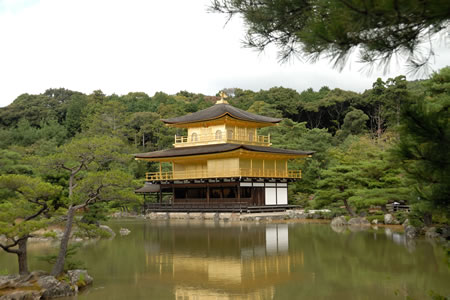English | Dutch |
|
| Kyoto: Asia’s most beautiful city? | |
Kyoto (Japan), September 15th 2010 |
|
“Kyoto is a city of secrets. Thousands of secrets. Hidden behind ancient walls, down tiny alleyways, under layers of gestures and artifice. Myriad pockets of incredible beauty that reveal themselves to those willing to see and discover.” If this introduction of Kyoto’s Lonely Planet doesn’t tempt you to go to this Japanese city, what will? We have five days to spend in Kyoto; the city which is named “Asia’s most beautiful city” by many guidebooks. Kyoto is a city that has been spared during the Second World War. The Americans claim that they deliberately spared the city to protect the Japanese cultural heritage for future generations, while others say that it was merely a matter of luck. Whatever the truth is, Kyoto is the place in Japan to see old temples in full glory. |
|
 |
|
Ivonne eating sushi with a lot of raw fish |
|
Daily, we walk many kilometres through the city. Kyoto is a city that begs to be explored on foot. Because of the high density of temples and palaces, there is always a sight nearby. Most interesting buildings are open for the public; some can be visited for free and for others you have to pay a high entrance fee. We are sticking mainly to the free sights and only single out the most important sights that you have to pay for. These are mostly not living up to our high expectations. Buildings are restored minutely and the large numbers of domestic and foreign visitors transform the temple into a kind of museum instead of a place of worship. We regard the Golden Pavilion as Kyoto’s one tourist trap. Together with a large group of people, we are shuffling through the entrance gate. It’s 09:30 a.m. on a Tuesday and the sight is open for half an hour, but already it is very busy. They haven’t tried to put the climax at the end of the visit. As soon as we entered the gate, we come face to face with the pavilion that is standing in a neatly maintained pond. We shamble further to get to the balustrade to make a picture and together with our fellow tourists, we follow the one-way path up a hill. We can get a last look of the pavilion before it disappears from our view. There is nothing else to do, than walking towards the exit while we are passing numerous souvenir stalls. This pavilion is Japan’s second most important tourist attraction (after Mount Fuji), but walking back to get another peak isn’t possible. Due to the herds of visitors it’s important that visitors don’t stay too long. One-way really means one-way! The quieter, free temples are more appealing. These are the places to sit on a bench to watch how ladies in traditional kimonos are drinking from the therapeutic temple well. In Kyoto you will definitely see some ladies wearing kimonos. It started when ladies were allowed to use the public transport for free on certain days if they are wearing a kimono, but they liked it so much that they are now also getting their kimonos out of the closet on other days. To see the ladies proudly walking on their wooden slippers is great fun. It made more impression than any of the temples that we visited during these days. We even were lucky enough to see two geishas walking in their beautiful clothes and with their eye-catching make-up. Very special, especially if you imagine that there are only 100 geishas active in Kyoto nowadays. | |
 |
|
The golden pavilion, a 'must-see' attraction in Kyoto |
|
| The food to replenish the lost energy is another big plus of the city. If you like the Japanese cuisine and are used to paying the inflated prices of Japanese restaurants in Europe, you will love dining in Kyoto (although the prices are still high for Asian standards). We have taken the opportunity to eat sushi in the country where they invented it and we tasted local specialities like okonomiyaki (a kind of pancake) and sake (rice wine). Whether you like the Japanese kitchen or not is a matter of taste, but you will definitely like the atmosphere in most restaurants. While sitting at a long counter, you can see how the chefs are preparing the meals. The smells and the colours are overwhelming.
After spending five days in Kyoto, we have made up our mind. We don’t regret coming to this city. Just being able to get a glimpse of Japanese life is already enough reason to come here. The Japanese people that we have met confirm the impression that we had on forehand: very correct and well-mannered people. They are proud of the rich history of their country and they show that. Many building in Kyoto underpin this rich history, but in the end we cannot conclude that Kyoto is Asia’s most beautiful city. We are not even placing it in our present top five (Phnom Penh, Hanoi, Bangkok, Kuala Lumpur en Kathmandu). The city is too modern and lacks the steamy and lively atmosphere that we like to find in an Asian city. That doesn’t mean that you shouldn’t visit Kyoto when you are in the area, but when you consider flying to Asia for a city trip, there are other cities that we would prefer. |
|